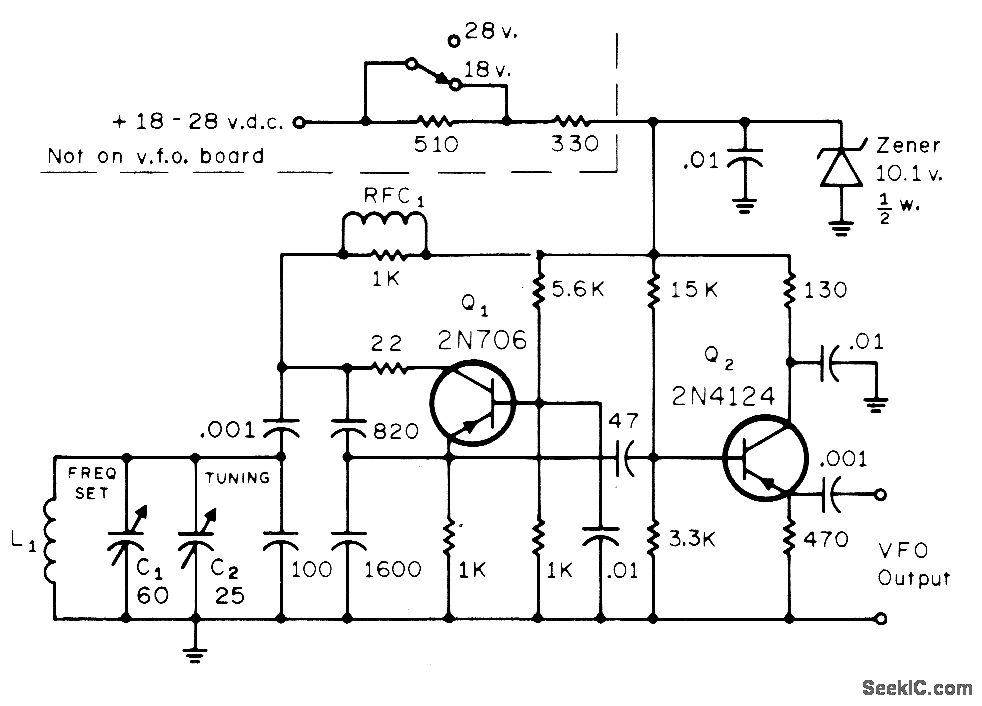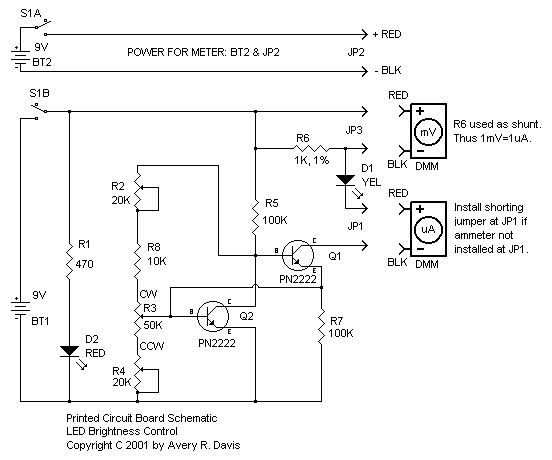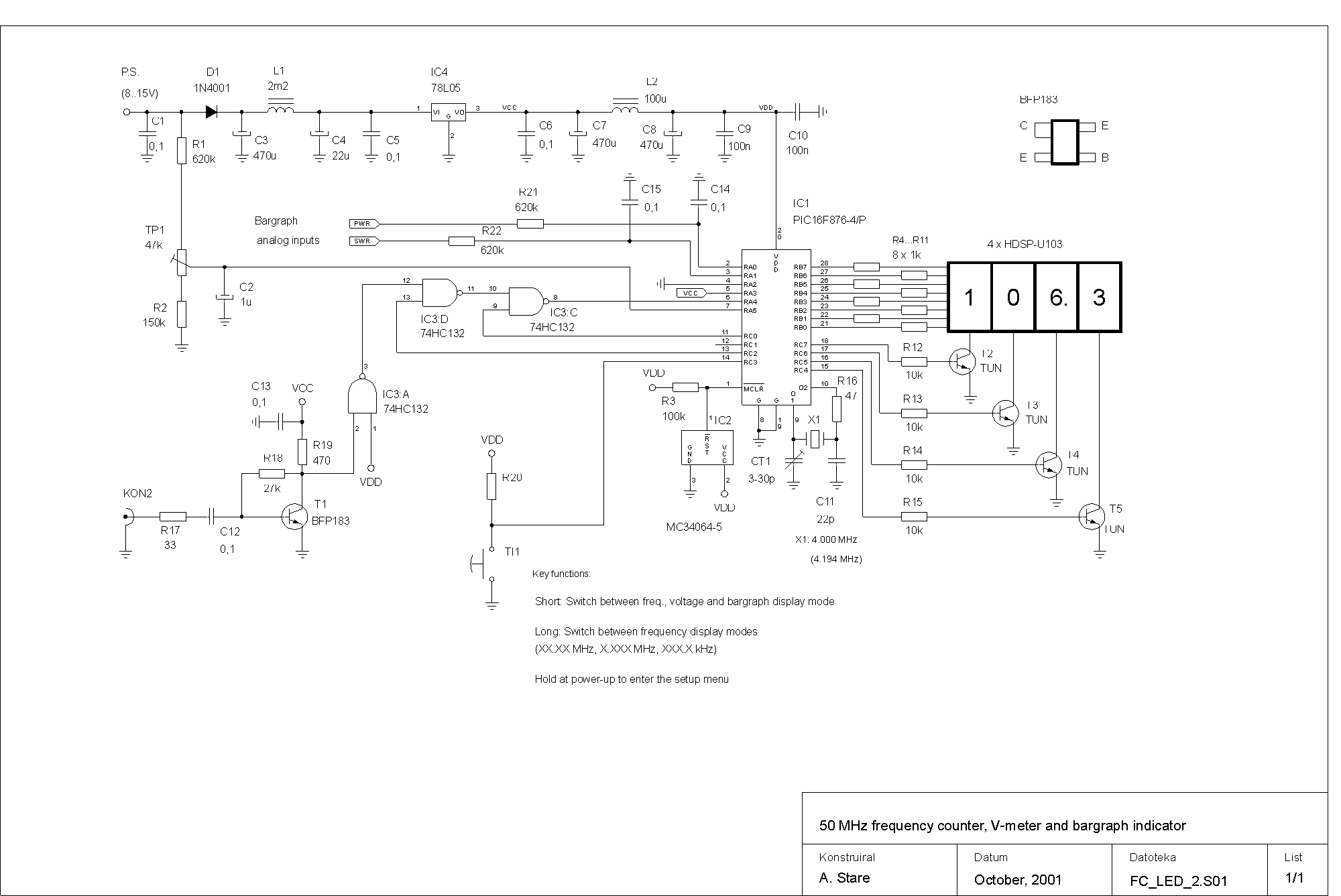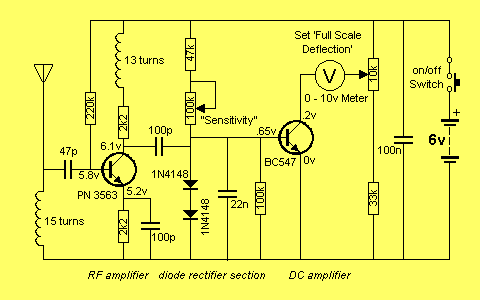
Sensitive field-strength meter
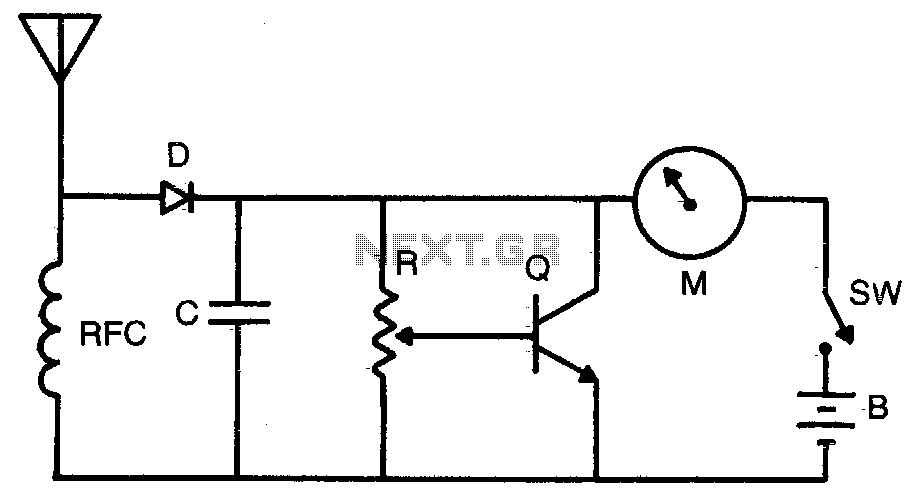
Increased sensitivity provides field strength readings from low-power transmitters. The operating range is 3-30 MHz. To operate, adjust R for Vz to Yz scale reading. RFC = 2 mH choke, C = 1,000 pF, R = 50 K potentiometer, M = 0 - 1 mA, D = IN34 or 1N60 (Germanium), Q = NPN (RCASK3020, 2N3904 or equivalent).
The circuit described is designed to enhance the sensitivity of field strength measurements, particularly for low-power transmitters operating within the frequency range of 3 to 30 MHz. This application is critical for various communications and broadcasting tasks where signal detection is essential.
The primary component for tuning the circuit is a variable resistor (potentiometer) labeled R, which is adjusted to achieve the desired voltage readings on the scale marked Vz to Yz. The adjustment of R allows for fine-tuning of the circuit's sensitivity to ensure accurate field strength readings.
The circuit includes an RFC (Radio Frequency Choke) rated at 2 mH, which serves to block high-frequency noise while allowing the desired RF signals to pass through. This is crucial for maintaining the integrity of the measurements by minimizing interference.
A capacitor (C) with a value of 1,000 pF is included in the design, which works in conjunction with the RFC to filter the signals and stabilize the circuit's response. The capacitor's role is to couple AC signals while blocking DC, further enhancing measurement accuracy.
The circuit also features a meter (M) with a range of 0 to 1 mA, which displays the output current corresponding to the field strength detected. This analog readout provides a direct and intuitive understanding of the signal strength.
For the detection component, a germanium diode (D) such as IN34 or 1N60 is utilized, known for its low forward voltage drop and high sensitivity at RF frequencies. This diode allows for efficient rectification of the RF signals, converting them into a measurable DC output for the meter.
Lastly, the circuit incorporates an NPN transistor (Q) such as RCASK3020 or 2N3904, which is used for signal amplification. The transistor enhances the weak signals captured by the antenna, ensuring that even low-power transmissions can be detected and measured accurately.
This combination of components creates a robust and sensitive field strength meter suitable for various applications in radio frequency detection and analysis.Increased sensitivity gives field strength reading from low power transmitters. Operating range 3-30 MHz To operate, adjust R for Vz to Yz scale reading. RFC = 2 mH choke, C = 1,000 pF, R = 50 K pot, M = 0 - 1 mA, D IN34 or 1N60 (Germanium), Q = NPN (RCASK3020, 2N3904 or equivalent).
The circuit described is designed to enhance the sensitivity of field strength measurements, particularly for low-power transmitters operating within the frequency range of 3 to 30 MHz. This application is critical for various communications and broadcasting tasks where signal detection is essential.
The primary component for tuning the circuit is a variable resistor (potentiometer) labeled R, which is adjusted to achieve the desired voltage readings on the scale marked Vz to Yz. The adjustment of R allows for fine-tuning of the circuit's sensitivity to ensure accurate field strength readings.
The circuit includes an RFC (Radio Frequency Choke) rated at 2 mH, which serves to block high-frequency noise while allowing the desired RF signals to pass through. This is crucial for maintaining the integrity of the measurements by minimizing interference.
A capacitor (C) with a value of 1,000 pF is included in the design, which works in conjunction with the RFC to filter the signals and stabilize the circuit's response. The capacitor's role is to couple AC signals while blocking DC, further enhancing measurement accuracy.
The circuit also features a meter (M) with a range of 0 to 1 mA, which displays the output current corresponding to the field strength detected. This analog readout provides a direct and intuitive understanding of the signal strength.
For the detection component, a germanium diode (D) such as IN34 or 1N60 is utilized, known for its low forward voltage drop and high sensitivity at RF frequencies. This diode allows for efficient rectification of the RF signals, converting them into a measurable DC output for the meter.
Lastly, the circuit incorporates an NPN transistor (Q) such as RCASK3020 or 2N3904, which is used for signal amplification. The transistor enhances the weak signals captured by the antenna, ensuring that even low-power transmissions can be detected and measured accurately.
This combination of components creates a robust and sensitive field strength meter suitable for various applications in radio frequency detection and analysis.Increased sensitivity gives field strength reading from low power transmitters. Operating range 3-30 MHz To operate, adjust R for Vz to Yz scale reading. RFC = 2 mH choke, C = 1,000 pF, R = 50 K pot, M = 0 - 1 mA, D IN34 or 1N60 (Germanium), Q = NPN (RCASK3020, 2N3904 or equivalent).
